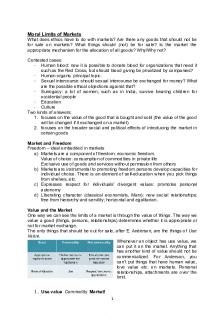2.1 The idea of Limits F19 PDF

| Title | 2.1 The idea of Limits F19 |
|---|---|
| Author | Not Anybody |
| Course | Calculus I |
| Institution | University of Illinois at Chicago |
| Pages | 2 |
| File Size | 54.8 KB |
| File Type | |
| Total Downloads | 45 |
| Total Views | 134 |
Summary
Limits Lexture 1, 2.1...
Description
2.1 The Idea of Limits Recall that the average velocity of an object which travels a distance d over a time period of duration t is vavg = dt . Question 1. How do you measure velocity? On his last vacation day Sparky D Dragon biked along the lake. He biked a total of 8 miles in 2 hours. What was his average velocity? Question 2. State the average rate of change for the following scenarios, being sure to include units. (a) It rained 4 inches over an 8 hour period.
(b) At 2 PM, the temperature was 82 degrees. At 5 PM the temperature was 76 degrees.
Question 3. Let’s say you travel 130 miles in 2 hours. What is your average rate of change (of distance per unit of time), or average velocity?
Is this how fast you drove throughout that entire time?
What do you think the difference between average velocity and instantaneous velocity is?
Recall that if you know the position of an object as a function of time f (t), the distance traveled from time t0 to time t1 can be calculated as f (t1 ) − f (t0 ). This means that average velocity can be expressed in these terms as vavg =
f ( t1 ) − f ( t0 ) . t1 − t0
Question 4. Sparky D Dragon, like other dragons, is afraid of eels. On his bike ride along the lake Sparky takes a break. While he is enjoying the view of the city an eel swims right up next to him startles him. He gets back on his bike and pedals as fast as he can to escape the eel. Suppose the distance between Sparky and the eel is given by the function f (t) = 2t2 + 10 measured in feet, and time in seconds. Find the average velocity in ft/s between: (a) t = 0 and t = 4 seconds
(b) t = 1 and t = 2 seconds
(c) t = 1 and t = 1 + h seconds
Definition: We say that a real number L is the limit of f (x) as x approaches a, written lim f (x) = L, if we can make the values of f (x) arbitrarily close to L by x→a
choosing x close enough to a (but not necessarily equal to a). Example 1. Let f (x) = x2 . We have the following table of values: x 2.1 2.01 2.001 f (x) 4.41 4.0401 4.004001 Notice that if the x-value has k zeroes after the decimal point, then the f (x)-value does as well. Since a large number of zeroes after the decimal point means that the number is very close to a whole number, we see that by making x arbitrarily close to 2, we get that f (x) is arbitrarily close to 4. Question 5. Evaluate the following limits: (a) lim (4 + 2x) x→0
(b) lim (4 + 2h) h→0...
Similar Free PDFs

2.1 The idea of Limits F19
- 2 Pages

Moral Limits of Markets
- 4 Pages

3 Bulkan The Limits of Constitution
- 35 Pages

9 limits of prerogative
- 9 Pages

Idea of Progress notion
- 2 Pages

IDEA and the IEP Process
- 5 Pages

IDEA and the IEP Process
- 6 Pages

PRESERVATION OF LIFE WITH LIMITS.
- 18 Pages

IDEA paper on the IEP
- 4 Pages

12 Key Components of IDEA
- 4 Pages

The Rise and Fall of Forever 21
- 1 Pages
Popular Institutions
- Tinajero National High School - Annex
- Politeknik Caltex Riau
- Yokohama City University
- SGT University
- University of Al-Qadisiyah
- Divine Word College of Vigan
- Techniek College Rotterdam
- Universidade de Santiago
- Universiti Teknologi MARA Cawangan Johor Kampus Pasir Gudang
- Poltekkes Kemenkes Yogyakarta
- Baguio City National High School
- Colegio san marcos
- preparatoria uno
- Centro de Bachillerato Tecnológico Industrial y de Servicios No. 107
- Dalian Maritime University
- Quang Trung Secondary School
- Colegio Tecnológico en Informática
- Corporación Regional de Educación Superior
- Grupo CEDVA
- Dar Al Uloom University
- Centro de Estudios Preuniversitarios de la Universidad Nacional de Ingeniería
- 上智大学
- Aakash International School, Nuna Majara
- San Felipe Neri Catholic School
- Kang Chiao International School - New Taipei City
- Misamis Occidental National High School
- Institución Educativa Escuela Normal Juan Ladrilleros
- Kolehiyo ng Pantukan
- Batanes State College
- Instituto Continental
- Sekolah Menengah Kejuruan Kesehatan Kaltara (Tarakan)
- Colegio de La Inmaculada Concepcion - Cebu




